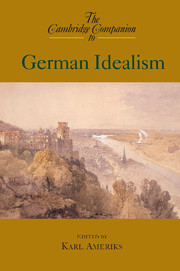Book contents
- Frontmatter
- Introduction
- 1 The Enlightenment and idealism
- 2 Absolute idealism and the rejection of Kantian dualism
- 3 Kant’s practical philosophy
- 4 The aesthetic holism of Hamann, Herder, and Schiller
- 5 All or nothing
- 6 The early philosophy of Fichte and Schelling
- 7 Hölderlin and Novalis
- 8 Hegel’s Phenomenology and Logic
- 9 Hegel’s practical philosophy
- 10 German realism
- 11 Politics and the New Mythology
- 12 German Idealism and the arts
- 13 The legacy of idealism in the philosophy of Feuerbach, Marx, and Kierkegaard
- Bibliography
- Index
11 - Politics and the New Mythology
the turn to Late Romanticism
Published online by Cambridge University Press: 28 May 2006
- Frontmatter
- Introduction
- 1 The Enlightenment and idealism
- 2 Absolute idealism and the rejection of Kantian dualism
- 3 Kant’s practical philosophy
- 4 The aesthetic holism of Hamann, Herder, and Schiller
- 5 All or nothing
- 6 The early philosophy of Fichte and Schelling
- 7 Hölderlin and Novalis
- 8 Hegel’s Phenomenology and Logic
- 9 Hegel’s practical philosophy
- 10 German realism
- 11 Politics and the New Mythology
- 12 German Idealism and the arts
- 13 The legacy of idealism in the philosophy of Feuerbach, Marx, and Kierkegaard
- Bibliography
- Index
Summary
Introduction
In its philosophical and political aspects the romantic movement is firmly linked to German Idealism. Like idealism, the philosophy of the romantics counts terms such as “organism,” “individuality,” and “imagination” as part of its systematic basis and distances itself from terms such as “mechanism,” “division,” and “atomism.” Even though German Idealism and the early romantic movement are characterized by a decidedly critical reaction to the Enlightenment, they agree with several of its key political convictions.
The turn of the century represents a break in romantic philosophy. The end of collaboration on the journal Athenaeum by Novalis and the brothers Friedrich and August Wilhelm Schlegel marks the transition to the later romantic period. The Berlin circle (1810–15) and the Vienna circle that formed around Joseph Görres after 1820 are important stages of this later period. Even though Fichte and Schelling still pursued ambitious speculative projects, the main figures of Late Romanticism lost interest in philosophical projects. Instead, the examination of the history of Christian and German culture, speculation on nature, projects in aesthetics, and, above all, a new formulation of concepts of the state and politics moved into the center of attention.
- Type
- Chapter
- Information
- The Cambridge Companion to German Idealism , pp. 219 - 238Publisher: Cambridge University PressPrint publication year: 2000
- 3
- Cited by



